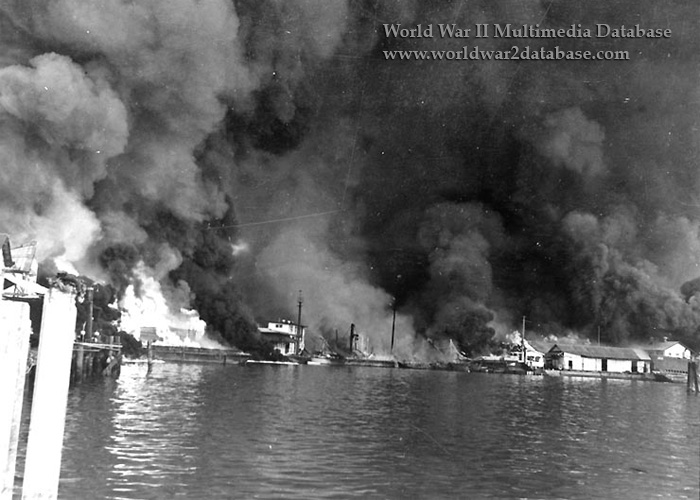| Fires at Cavite Navy Yard resulting from the Japanese air raid on December 10, 1941. Fifty-four bombers of theEleventh Air Fleet were detailed from Formosa and attacked at 1300 hours. Twenty-seven attacked ships and small craft in the bay and the remainder went on toward Cavite, dropping their bombs from a height of 20,000 feet, above the range of the nine 3-inch anti-aircraft guns protecting the base. Almost every bomb fell within the Navy Yard. After the first run, the first flight of twenty-seven withdrew and the other twenty-seven bombers, having completed their attack against ships in the bay, flew in to strike the targets. The attack lasted for two hours. The entire yard was set ablaze; the power plant, dispensary, repair ships, warehouses, barracks, and radio station received direct hits. Greatest damage was done by the fire which spread rapidly and was soon out of control. Admiral Rockwell estimated that five hundred men were killed or seriously wounded. The covered self-propelled lighter YF-181 – perhaps visible in the right center – is loaded with almost 200 burning torpedos, which will be consumed in the flames, crippling the offensive capability of the United States Navy Asiatic Fleet‘s submarines. At the time this photograph was taken, small arms ammunition was exploding in the center of the heavy blaze on the left. The submarine whose bow is visible at the far right is probably USS Sealion (SS-195), hit by bombs and had settled by the stern. Sealion, a 1450-ton Sargo class submarine, was commissioned in late November 1939 and, in the spring of 1940, deployed to the Far East to strengthen the defenses of the Philippines as relations with Japan deteriorated. Sealion was nested at Machina Wharf with USS Seadragon (SS-194) inboard and minesweeper USS Bittern (AM-36) outboard. Most Sealion personnel were below decks. The first stick of bombs landed from 100 to 200 yards (90 to 180 meters) astern of Sealion; all hands were ordered all hands below. On the second bombing run, two bombs hit Sealion almost simultaneously. One struck the after end of the conning tower fairwater, completely demolishing the machine gun mount which had just been vacated, the main induction, the battery ventilation and the after conning tower bulkhead. It exploded outside the hull a few feet above the control room. Had it entered the hull before exploding, the majority of Sealion‘s crew would have been lost, as most of the personnel were in that room. A fragment from this bomb pierced the conning tower of Seadragon, instantly killing Ensign Samuel H. Hunter, Jr. (August 20, 1914 – December 12, 1941) stationed there, the first submariner casualty of the war. Other fragments from this bomb pierced Sealion‘s pressure hull, inflicting minor wounds on three men in the control room. At almost the same instant another bomb, passing through the main ballast tank and the pressure hull, exploded in the maneuvering space in the after end of the after engine room, killing four men working in that compartment – Chief Electrican‘s Mates Sterling C. Foster (November 1, 1910 – December 10. 1941), Melvin D. O‘Connell (June 6, 1911 – December 10. 1941) and Vallentyne L. Paul (July 8, 1921 – December 10. 1941), and Machinist‘s Mate First Class Ernest E. Ogilvie (August 1, 1913 – December 10, 1941). With this explosion in the maneuvering space, the after engine room flooded immediately and Sealion settled by the stern in the mud. The forward engine room and the after torpedo room flooded slowly through bomb fragment holes in the bulkheads. Personnel in these compartments, as well as in other parts of the ship, escaped through the hatches, which were all still above water. Sealion finally settled down by the stern with about 40% of the main deck underwater and 15 ‚àû list to starboard. The bomb which exploded above the control room, while doing great superficial damage, did little harm to the pressure hull other than piercing it with numerous bomb fragments. The bomb which exploded aft did the major damage. A more vital spot than the maneuvering space could not possibly have been found. All motor control, reduction gears, and main motors were wrecked, totally immobilizing the ship. On the morning of December 11 the fires at Cavite were burning more fiercely than ever. There was no chance of saving the yard. However, the damage would have been considered non-fatal had there been overhaul facilities available for repairs. But such was not the case; the bombing which wrecked Sealion also demolished the Navy Yard Cavite, and the closest repair facilities were at Pearl Harbor, 5000 miles away. The war situation being what it was, it was impossible to tow Sealion that distance, and after removing all gear of value, such as gyro, radio and sound equipment, she was destroyed to prevent her from falling into enemy hands. Three depth charges were exploded inside Sealion on December 25, 1941. The first American submarine lost in World War II, her remains were broken up following the conflict‘s end. There is some debate about the disposition of the crew remains left in the aft section. | |
| Image Filename | wwii1434.jpg |
| Image Size | 143.51 KB |
| Image Dimensions | 700 x 500 |
| Photographer | Unknown |
| Photographer Title | Unknown |
| Caption Author | Jason McDonald |
| Date Photographed | December 10, 1941 |
| Location | Machina Wharf |
| City | Cavite Navy Yard |
| State or Province | Luzon |
| Country | Philippines |
| Archive | National Archives and Records Administration |
| Record Number | Signal Corps #130991 |
| Status | Caption ©2010, ©2024 MFA Productions LLC Image in the Public Domain |

Author of the World War II Multimedia Database

